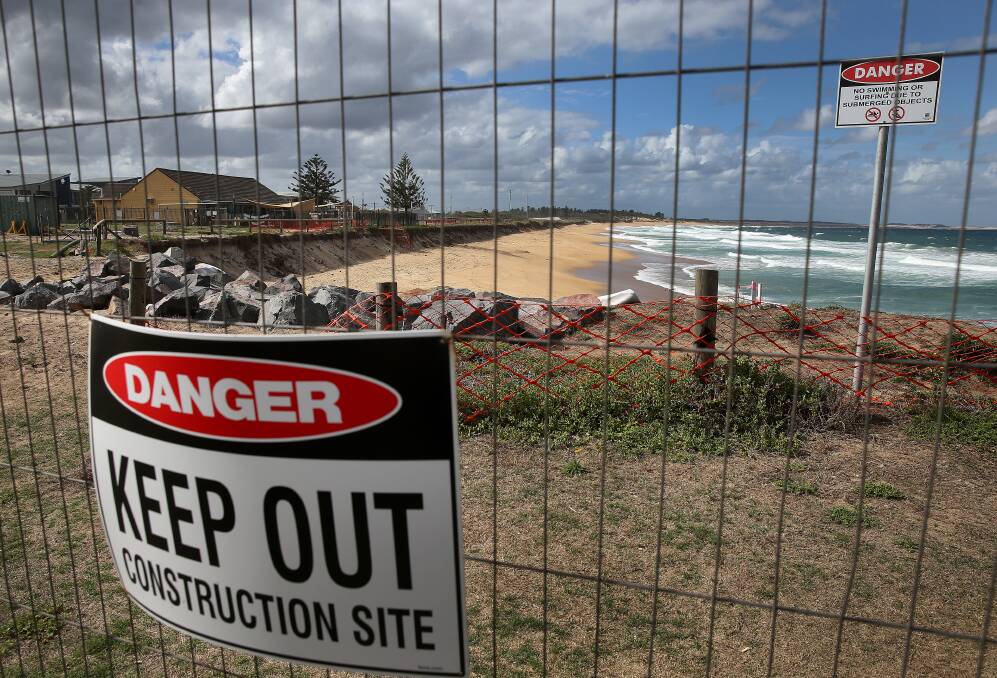
STOCKTONS fragile shoreline is disappearing at the alarming rate of a metre each year.
Subscribe now for unlimited access.
or signup to continue reading
With no long-term solution to halt the erosion, the coastline is being stripped annually of hundreds of thousands of tonnes of sand.
The suburbs erosion and infrastructure losses will continue to grow.
The Stockton bowling and tennis clubs will come under threat, the Stockton Surf Life Saving Club, child-care centre and beach access road will be swallowed by the sea.
Each year east coast low storm surges will push huge waves into the Mitchell St rockwall leaving residents fearing what will be left of their homes when the storm passes.
That is the stark reality that faced hundreds of frustrated residents who attended a community information session at Stockton RSL on Wednesday night to discuss the suburbs long-standing erosion crisis.
Breakwalls, groynes, artificial reefs, other off-shore structures and sand replenishing are among the solutions so far discussed.
But residents left Wednesdays community meeting with another unlikely solution to the environmental disaster that is destroying their beach.
A united community front and sound business case to attract funding.
Newcastle Lord Mayor Nuatali Nelmes, who hosted the forum, told residents it was the only way forward to halt the disappearing shoreline.

While acknowledging community frustration at the lack of a solution to save the beach, she said there was a process council had to follow to attract funding for the project.
The cost of long-term solutions, some estimated to be more than $30 million, was beyond council and the community needed state government support.
What we need is a unified solution as a community and local government, and the next challenge is getting the funding..., she said. If we stand together Im hoping we can get the funding for a solution.
Resident Phillip Mallows received a large round of applause when he detailed how locals were fed up with short-term solutions that washed away in the next storm.
I get fairly disheartened by watching excavators take sand from one part of an eroded beach and put it on another part of an eroded beach, Mr Mallows said.
The meeting heard a plan would be developed by council staff and Stockton community members in the next six months identifying short and medium-term solutions to address the erosion.
Council would then have another two years to lodge a coastal management program that would include long-term solutions. Both plans will be used in an effort to attract funding.
The Office of Environment and Heritages principal coast specialist Phil Watson told the meeting he attended a similar gathering in Stockton in 1995.
Its with a sense of regret that here we are 23 years later...and we still dont have a solution, he said. Regrettably weve heard it before.
Mr Watson said long-term solutions had never been looked at in an appropriate level of detail.
He said planned retreat from the sea was a legitimate option and cautioned residents they were competing against everything else in the state budget for funding.

Were going to have to build a business case...its a very large capital expenditure, he said.
When questioned why Stockton didnt meet the criteria to be classified by the state government as an erosion hotspot to qualify for additional funding, Mr Watson said the suburb didnt have to meet the criteria to get funding.
Stockton has always been recognised by the state government as a place where erosion is a critical issue, he said.
Were doing away with the hotspots because its largely irrelevant.
The Newcastle Herald reported last month that the Environment Minister Gabrielle Uptons chief of staff, Kevin Wilde, wrote to Newcastle MP Tim Crakanthorp outlining the governments position on the erosion problem.
Addressing the coastal erosion issues at Stockton is the responsibility of Newcastle City Council, Mr Wilde wrote.
He went further to state that Stockton did not meet the criteria to be classified a coastal erosion hotspot.
Residents at the meeting heard that it was Port of Newcastle infrastructure, the breakwalls, causing the erosion by trapping shore drift sand at Nobbys.
Several residents argued the owners of the port should be held responsible for funding a solution to fix Stockton beach.
The Port of Newcastle was privatised in 2014 for $1.75 billion to a 50/50 joint venture between Chinese and Australian interests. Soon afterwards, the new owners revalued the business to be worth $2.4 billion.
Residents also argued that the NSW government, that receives millions each year in coal royalties derived from the port, should help foot the bill.

Councils senior strategist environment, Mark Manning, said investigations had been made about a bypass system to move excess sand trapped at Nobbys to Stockton but council was told it would interfere with the operation of the port.
Each year the harbour dredge dumps 30,000 tonnes of sand off the Stockton coast as part of a sand replenishment strategy, but experts told the meeting the beach needed another hundred-fold more than that.
Meanwhile, Mission Australia Early Learning Centres general manager Ben Williams said the child-care operator was looking for another site in Stockton.
Mr Williams urged anyone with commercial land to contact Mission Australia to discuss options.
He detailed a critical shortage of child-care places on the peninsula and said the centre cared for 90 children.
Mission Australia has applied for grant funding to relocate its newly refurbished $160,000 playground, that is about to crumble into the sea, to the northern side of the building. The centres lease on the council building expires in 2020. Mr Williams said while Mission Australia was committed to the community, the organisation provided child care and was not a property developer.
A petition organised by Mr Crakanthorp to save Stockton Beach has reached 5000 signatures, but needs 10,000 to trigger a debate in parliament.


